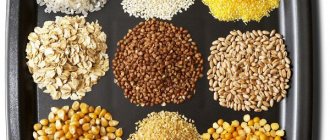Nutritional value of grapefruit
| Component | Content per 100 g of product, g | % Daily Value |
| Squirrels | 0,8 | 1 |
| Fats | 0,1 | 0,2 |
| Carbohydrates | 10,7 | 3,4 |
| Water | 88,8 | 3,47 |
| Fiber, dietary fiber | 1,9 | 9 |
| Fructose | 1,0 | 2,9 |
| Glucose | 2,0 | 20 |
B vitamins are responsible for the proper functioning of the nervous system, protect against stress, and improve brain activity.
Folic acid is a mandatory component for pregnant women, as it eliminates the risk of fetal malformations.
Composition of grapefruit
The composition of grapefruit explains its benefits for the human body. This is a dietary product: 100 g of pulp contains 35 calories. Among the nutrients, carbohydrates are the leaders, mainly in the form of mono- and disaccharides. The benefits of grapefruit are related to its fiber content. The product contains vitamins, micro- and macroelements, organic acids.
Chemical composition of grapefruit
- iodine;
- cobalt;
- zinc;
- fluorine;
- ascorbic acid;
- vitamin B9;
- iron;
- manganese;
- magnesium;
- phosphorus;
- copper;
- potassium;
- sodium.
BJU grapefruit
The benefits of grapefruit for women and men are related to its composition - per 100 g:
- proteins - 0.7 g;
- water - 90.9 g;
- lipids - 0.2 g;
- inorganics - 0.31 g;
- fiber - 1.8 g;
- sugars - 6.98 g;
- carbohydrates - 6.5 g.
Chemical composition of grapefruit. Photo: dietmap.ru
Mineral composition
| Minerals | Content per 100 g of product, mg | % Daily Value |
| Potassium | 184 | 7,4 |
| Calcium | 23 | 2,3 |
| Magnesium | 10 | 2,5 |
| Iron | 0,5 | 2,8 |
| Phosphorus | 18 | 2,3 |
| Sodium | 13 | 1 |
Grapefruit is not high in micronutrients. Its use can only be a useful addition to the main sources of these necessary components.
- potassium is responsible for the normal functioning of the heart and blood vessels;
- calcium ensures strong bones and teeth;
- magnesium is a well-known anti-stress microelement;
- iron is involved in hematopoiesis and saturates cells with oxygen;
- phosphorus fills the body with energy;
- sodium regulates metabolic processes and maintains water-salt balance.
Calorie content
The energy value of citrus is 35 kcal per 100 grams of product. Grapefruit is a low-calorie food. It is often included in diet menus for weight loss. Another advantage for those who want to maintain their figure is its low glycemic index - 25 units, as well as a low sugar content.
Vitamin content
| Vitamins | Contents per 100 g of product | % Daily Value |
| A (retinol) | 345 mcg | 33 |
| Beta carotene | 686 mcg | 13,7 |
| C (ascorbic acid) | 31.2 mg | 34 |
| E (tocopherol) | 0.1 mg | 0,9 |
| B1 (thiamine) | 0.05 mg | 3,3 |
| B2 (riboflavin) | 0.03 mg | 1,7 |
| B3 (nicotinic acid) | 0.2 mg | 1,3 |
| B4 (choline) | 7.7 mg | 1,5 |
| B5 (pantothenic acid) | 0.3 mg | 5,2 |
| B6 (pyridoxine) | 0, mg | 4,1 |
| B9 (folic acid) | 13 mcg | 3,3 |
The vitamin composition of grapefruit is quite rich, despite the low concentration of nutrients. Nevertheless, they are all vital for the body:
- Vitamin A and beta-carotene are powerful antioxidants. They are responsible not only for eye health. These vitamins promote the production of collagen, therefore they are indispensable for blood vessels and skin. In red grapefruit their content is higher than in other varieties;
- Vitamin C is a source of strong immunity and has anti-inflammatory properties. It must be obtained in sufficient quantities from food, since it is not synthesized in the body;
- Vitamin E is considered the “vitamin of youth”. It prevents cells from aging, cleanses the body of toxins and harmful substances;
- B vitamins are responsible for the proper functioning of the nervous system, protect against stress, and improve brain activity. Folic acid is a mandatory component for pregnant women, as it eliminates the risk of fetal malformations.
Benefits of grapefruit
The low calorie content and high nutritional value of grapefruits allows them to be used as a prophylactic and vitamin complex.
Regular consumption of the product improves the functioning of the brain and internal organs, increases body tone, and provides additional energy. Grapefruits are also beneficial for people after surgery.
Beneficial properties of grapefruit as part of kBZHU:
- improvement of immunity;
- normalization of glucose levels in diabetes mellitus;
- blood thinning;
- elimination of inflammation in the oral cavity
- decreased acidity levels in the stomach;
- lowering cholesterol levels;
- elimination of blood clots in blood vessels;
- normalization of appetite and improvement of the digestive system;
- stimulation of metabolic processes;
- liver cleansing;
- high nutritional value.
- improving the functioning of the nervous system;
The product is used to make cosmetic preparations. Citrus affects age spots and freckles on the skin, making them less noticeable. Grapefruit is also used to make face masks and tonic gels. To make hair stronger and thicker, prepare grapefruit oil. Half a large grapefruit or one whole grapefruit per day is enough to provide the body with useful substances.
Useful properties of peel and seeds
The zest helps fight infections
Like the pulp, grapefruit peel contains beneficial components. It is low in carbohydrates and the fat content is at an average level. It helps relieve stomach pain and eliminates burning sensation. The top layer of zest is peeled off the skin and chewed 2-3 times a day. The zest also has an anti-infective effect. The low calorie content of grapefruit allows you to consume its skin and pulp when losing weight.
The low amount of calories in the seeds allows them to be used to make a healing extract that reduces the number of harmful bacteria in the body and eliminates infections. On average, 1 tbsp is enough for prevention. funds in 2 days. The advantage of such a medicine is that microbes do not adapt to its action. The extract is also used to combat skin diseases and infectious diseases of the respiratory organs.
Chem. bone composition:
- glycoside;
- quarticine;
- bioflavonoid;
- rutinosaide.
Mineral composition
| Minerals | Content per 100 g of product, mg | % Daily Value |
| Potassium | 184 | 7,4 |
| Calcium | 23 | 2,3 |
| Magnesium | 10 | 2,5 |
| Iron | 0,5 | 2,8 |
| Phosphorus | 18 | 2,3 |
| Sodium | 13 | 1 |
Grapefruit is not high in micronutrients. Its use can only be a useful addition to the main sources of these necessary components.
- potassium is responsible for the normal functioning of the heart and blood vessels;
- calcium ensures strong bones and teeth;
- magnesium is a well-known anti-stress microelement;
- iron is involved in hematopoiesis and saturates cells with oxygen;
- phosphorus fills the body with energy;
- sodium regulates metabolic processes and maintains water-salt balance.
Properties of grapefruit
This citrus is probably the only fruit that causes so much controversy about its properties. The composition of the fruit leaves no doubt about its usefulness. However, in recent years, one can increasingly hear about the results of studies that prove its undoubted harm and even danger to human health.
Let's take a closer look at the properties of grapefruit, both beneficial and harmful. Everyone will be able to draw a conclusion for themselves whether to be friends with this fruit or avoid it.
Benefit
The vital substances that make up grapefruit have a beneficial effect on the condition of the body. In some cases, this fruit is used in folk medicine to treat diseases.
Strengthens immunity
Citrus fruits are often consumed during colds or during the season of viral epidemics. Grapefruit contains a lot of vitamin C and other antioxidants, which have strong anti-inflammatory and antimicrobial properties. They will cope with any viral attack, and will also help you recover quickly and restore strength after a long illness. Due to the high content of essential oils, even when inhaling the aroma of grapefruit, processes of stimulation of the immune system are triggered.
Improves bowel function
Fiber and dietary fiber perform a high-quality “spring cleaning” of the digestive tract, gently removing all accumulated waste, toxins, cholesterol and food waste from the body. The high content of acids and essential oils accelerates the digestion process, preventing fermentation and gas formation. Grapefruit is recommended to be consumed with low stomach acidity.
Protects the heart and blood vessels
Antioxidants and naringin help reduce “bad” cholesterol, which reduces the risk of blood clots. Vitamins C and A provide elasticity to blood vessels. Grapefruit is recognized as an excellent remedy for the prevention of stroke, heart attack, and atherosclerosis. Its use improves blood circulation, normalizes heart rhythm and lowers blood pressure. For vascular and heart health, it is enough to drink 50 grams of juice or eat a couple of slices of the fruit before meals.
Important! It is forbidden to consume grapefruit together with medications that lower blood pressure and cholesterol levels! Citrus blocks the removal of these drugs from the body, which can lead to negative health effects.
Reduces blood sugar levels
It has been scientifically proven that naringin can slow down the growth of glucose and even reduce its quantitative indicators after meals. In addition, grapefruit has a low glycemic index. Diabetics should definitely include this fruit in their diet, and they should eat it without peeling the delicate skin and partitions.
Normalizes the functioning of the nervous system
Essential oils, B vitamins, magnesium - a powerful complex of antidepressants. Grapefruit juice and fruits tone, give strength and energy, help cope with stress and irritability. The fruit is useful for women during menopause, as well as for mothers who suffer from postpartum depression. Grapefruit oil is widely used in aromatherapy as an invigorating agent and an aphrodisiac.
Takes care of the skin
In cosmetology, citrus fruit is used to rejuvenate the skin of the face and body. It tones, eliminates wrinkles, eliminates rashes, age spots and oily shine. Successfully used to combat cellulite. The fruit pulp or oil is used for wraps and massage.
Promotes weight loss
Initially, there was an opinion that grapefruit burns fat. This has become the reason for the high popularity of the fruit among those losing weight. This myth has been dispelled. Nevertheless, there was some truth in it. Grapefruit can really help you lose extra pounds.
It accelerates metabolic processes, reduces appetite, has a mild choleretic and diuretic effect and at the same time contains a minimum of calories. This is an ideal product to combat excess weight. For maximum effect, it is recommended to eat several slices immediately after eating.
Harm and contraindications
The dangers of grapefruit have long been a topic of debate and discussion. Perhaps this citrus hybrid does more harm to the body than good. There are several good reasons why you should stop using it:
- Due to its high acid content, it has a strong irritant property. For people with gastritis, ulcers, or high stomach acidity, this fruit is forbidden. It can provoke severe pain and exacerbation of diseases;
- Like all citrus fruits, grapefruit has a negative effect on tooth enamel. If you have dental problems or increased tooth sensitivity, it is better to exclude it from the menu or rinse your mouth thoroughly or brush your teeth immediately after consumption;
- According to the results of scientific research that lasted more than 20 years, disappointing conclusions were drawn. It turned out that grapefruit, like all citrus fruits, contains psoralen. It increases the skin's sensitivity to ultraviolet radiation. This can cause the development of skin and breast cancer. It has been established that of all citrus fruits, grapefruit has the strongest such side effect;
Important! Do not eat grapefruit or drink juice from it while in direct sunlight!
- the fruit is incompatible with many medications. The active substances in grapefruit inhibit and inhibit the work of liver enzymes, which are responsible for the absorption and excretion of active medicinal components from the body. As a result, their concentration can increase several times, which will inevitably provoke side effects from an overdose. It is very dangerous! There are more than eighty names of such drugs. These include statins, antihistamines and psychotropic drugs, and medications that lower blood pressure. While taking any medications, it is better to avoid grapefruit altogether or consult your doctor in advance.
Attention! The interval between taking medications and drinking grapefruit or its juice should be at least 4 hours!
How to use
For weight loss, it is used not only as a whole fruit, but also in the form of juice, salad additives, and essential oil.
Fresh grapefruit
There are specially designed diets, but proper inclusion of fruit in the daily diet is also useful. There are several ways to use it for weight loss:
- It is recommended to eat grapefruit half an hour before each meal. Due to decreased appetite, food portions will decrease.
- It satisfies the feeling of hunger, so no additional food intake is required before lunch.
- Grapefruit for weight loss at night is especially effective, since the bulk of fat is deposited in the body from dinner.
- If you have a juicer, you can make juice that can help you lose weight.
- The fruit is combined with berries and fruits to prepare and.
- Used as a component of salads.
- The grapefruit diet lasts from 3 to 14 days. The diet is based on replacing your usual food for breakfast or dinner with grapefruit, and the rest will be light and low-fat food. This is either boiled fish or chicken, or a vegetable salad, seasoned with lemon juice.
When using the grapefruit diet, it is recommended to consult a nutritionist or doctor, since the presence of one contraindication leads to unpleasant consequences. If you are going to go on this diet for the first time, then choose the right option - proven and with a minimum number of days.
Essential oil
Grapefruit oil for weight loss is used externally or internally. In the latter case, the bottle or instructions indicate that the oil can be eaten. Then drop 4-5 drops onto a slice of bread and eat it to suppress hunger. Used as an additive to. Grapefruit essential oil can be used externally for weight loss in various ways.
- . It is required not as a separate component, but as an additive to the main one. The wrap is based on clay, seaweed or, to which 5-10 drops of grapefruit oil are added.
- Massage. Mixes with olive or vegetable oil. It is recommended to apply after showering or bathing to problem areas.
- Fragrant baths. Add 8-10 drops. First you need to dissolve grapefruit oil in milk.
- Aromatherapy. Inhaling vapors dulls the feeling of hunger.
Proper consumption of grapefruit reduces weight and benefits the entire body. But contraindications and possible harm reduce its use.
THESE ARTICLES WILL HELP YOU LOSE WEIGHT
Your feedback on the article:
Grapefruit is rightfully considered one of the important products for maintaining an ideal figure. This Barbadian citrus contains an incredible amount of useful substances necessary for every body, and its tart, memorable taste will not leave anyone indifferent. In this article we will try to consider in detail how to correctly select, store and consume this product, as well as its chemical composition and calorie content.
How to choose?
The main signs of a ripe and tasty grapefruit:
- bright skin color. The richer the shade, the sweeter the citrus taste. It will be especially successful to find a fruit with red spots;
- Smooth surface. The fruit should not have dents, scratches or darkened spots;
Important! You should not buy grapefruit with an unnatural glossy peel. The fruit, which seems beautiful and fresh, is actually treated with chemicals.
- rich aroma. If the fruit does not smell, it means it is unripe or not fresh;
- large size. The small fruits have a thick skin and a bitter taste. The larger the citrus, the thinner the peel, and the sweeter it will be. Ripe fruits are not only larger, but also much heavier in weight.
Application
Grapefruits are eaten fresh and added to desserts and fruit salads. They are used to produce juice, liqueur, jam, marmalade, and are used as a seasoning for meat dishes and in the confectionery industry. The acid contained in the pulp has a destructive effect on tooth enamel. Grapefruit juice irritates the gastrointestinal mucosa, so it should not be consumed by people with high stomach acidity, gastritis, ulcers, enteritis, colitis, or inflammatory bowel diseases. The peel is used to make candied fruits and essential oil, which is in demand in the alcoholic beverage and perfume industries.
Market Analytics
- Black Lives Matter movement: reaction and consequences for the beauty industry
- COVID-19 is changing the rules of the game in the cosmetics market
- Beauty of the future: cosmetic innovations 2020
Convenient search for beauty salons on our website
Beauty salons in Moscow Beauty salons in St. Petersburg Beauty salons in Ekaterinburg Beauty salons in Novosibirsk
Latest blog posts on our website
- Naturecream / Apricot kernel oil for face
- Naturecream / MATRIXYL3000 - the best skin elasticity stimulator
- Naturecream / SPF in Natural Oils
- Naturecream / Geranium (Pelargonium) oil for skin health and beauty
- Prostye-sovety / Save on a beauty salon: procedures that can be done at home
- Naturecream / Growth Factor - brings back youth?
- Oksana-Lezina / 3 effective abdominal exercises from a fitness instructor for beginners
- Prostye-sovety / Making perfect curls at home
- Prostye-sovety / Which hair removal method to choose
- Naturecream / Wrinkles Puppets
Latest forum topics on our website
- Natalya / How to properly make a gelatin mask?
- Mrs._Smith / Badly sunburned! What to do?((
- Ice / Is it necessary to combine fitness classes with a diet?
- Antonova / What can be used for hair loss?
- Radio operatorKat / Who was on a protein diet?
Other articles in this section
| Sweetie The universal love for citrus fruits, coupled with modern breeding capabilities, allowed scientists in 1984, by crossing white grapefruit and pomelo, to create a new species - sweetie. Sweet fruits are round in shape, green in color, with a smooth, shiny, thick skin and light yellow flesh. Unlike its parents, Sweetie is not as big as a pomelo and sweeter than a grapefruit. The hybrid got its name from the main characteristic for which it was created - Sweetie means sweet. |
| Salak Salak, salacca or "snake fruit" are the fruits of a tropical palm tree. They grow in clusters and are located at the base of the trunk. The brown fruits are oval or pear-shaped, often in the form of a droplet. They have a scaly, rough skin that resembles snake skin. The sweet, aromatic pulp, yellowish-beige in color, has a specific taste and consists of segments containing one easily separated dark seed. The taste of herring varies and depends on where it grows. In Thailand, this fruit is quite sour and resembles gooseberries or sea buckthorn. In Malaysia and Indonesia, the fruit tastes like a mix of pineapple and banana with a slight nutty flavor and peach aroma. |
| Syzygium Syzygium is a flowering plant of the Myrtaceae family, which has more than 1000 species. Most representatives of the genus Syzygium are ornamental evergreen trees and shrubs, and only a few species are grown for their edible fruits: Malay apple, Rose apple, Jambolan, etc. The fruits of Syzygium are pinkish-red in color, pear-shaped or cylindrical in shape and grow no more than 3 cm in length. The dense, fleshy, refreshing pulp with the aroma of cloves and cinnamon (the fruits of the Rose Apple variety smell like roses) is covered with a thin, waxy peel. There are several seeds inside the fruit. |
| Barberry Lush barberry bushes with thin thorns can be found not only on forest edges and slopes of ravines, but also on city streets, because they are used as an ornamental plant and hedge. Barberry is a honey-bearing and medicinal plant; all its parts are used in folk medicine: fruits, leaves, bark and roots. Barberry fruits are collected in clusters. Small oblong dark red berries contain several seeds, the pulp is juicy and very sour. |
| Cherry Cherry fruits are small drupes up to 2 cm in diameter, oval or heart-shaped. They have sweet, juicy, fleshy flesh and a small round seed. The color of cherries depends on the variety and can be yellow, red, pink and almost black. Dark cherries contain many carotenoids and anthocyanins. |
| Peach Peach fruits have very juicy and tender pulp. Depending on the variety, they are round or oval in shape with a groove on one side and thin skin, usually covered with fluff. The stone is medium in size, of a characteristic shape with one pointed end and an uneven surface covered with dimples and grooves. The flesh of peaches comes in cream, yellow and pink colors. Depending on the appearance of the fruit, 4 classes are distinguished: “real peaches” with velvety skin, the pulp of which is easily separated from the pit; naked “nectarines” with pulp that easily separates from the stone; “pavies” - the fruits are velvety, the pulp does not separate from the stone; “brugnons”, “violettes” - the fruits are bare, the stone is not separated from the pulp. |
| Plum Plums have small round or oblong fruits with dense, fleshy, sweet and sour pulp and a hard, inedible pit. The color and chemical composition of the fruit depends on the variety; plums are yellow, green, red, blue and purple. At the same time, yellow fruits contain more vitamin C and vitamin E, and dark varieties contain anticyanins. Thanks to the work of breeders, there are many different varieties of plums; the following varieties are common in central Russia: sloe, domestic plum, Ussuri plum, damson plum and Chinese-American hybrids. |
| Edible honeysuckle Edible honeysuckle is widespread in nature in Eastern Siberia, Kamchatka and Sakhalin. This frost-resistant plant easily tolerates frosts of 20 degrees, and its flowers and shoots will not die, even if the thermometer drops to -5°C. Honeysuckle is a branched shrub about 2 m high. In early May, fragrant yellow flowers bloom on the branches and already in June the fruits ripen - oblong dark purple berries with a bluish bloom. The taste of the fruit depends on the place where the plant grows and can be sour with a spicy bitterness, sour-sweet and sweet. |
| Guava Guava resembles small, thin-skinned apples with many hard seeds inside. The fruits have a slightly bumpy surface, round or pear-shaped, and become yellow when ripe. The pulp can be of different shades: white, pink or red, has a bittersweet taste, reminiscent of both pineapple and strawberry, and a delicate aroma. |
| Cherry plum Cherry plum is a type of traditional fruit plum. This heat-loving and very capricious plant is grown in the southern regions. The fruits of cherry plum are sweet and sour, round in shape, small in size, yellow, pink, red, purple or almost black in color. Tasty and aromatic cherry plum has many medicinal qualities. |
How to clean the fruit?
Before peeling and eating the fruit, it must be thoroughly rinsed under water. You can even rub the peel with a soft brush to ensure that you get rid of dirt and chemicals that may have been used on the fruit.
There are several options to get to the juicy grapefruit pulp:
- If the bitterness of the fruit does not bother you, then you can carefully cut off the top and bottom with a knife without touching the pulp, remove the peel with your hands and divide the fruit into slices. By leaving white films and partitions, we will retain maximum benefits in grapefruit. If desired, you can extract the pulp from the slice. It is enough to simply cut off a thin strip of the white part from the narrowest place and turn the slice inside out.
- When you want to eat a fruit without much effort, you can simply cut it into two halves and arm yourself with a spoon. You need to eat citrus by carefully scraping the pulp from the halves, while separating it from the partitions. Interestingly, there are even special spoons on sale for eating grapefruit with jagged edges.
- A more painstaking method is suitable for cases when neat, peeled pieces of pulp are needed. For example, for a salad. To do this, the first thing you need to do is peel the fruit. You can remove it either by hand or by carefully cutting it off into a thin film with a sharp knife, being careful not to grab the pulp. Next, making longitudinal cuts from the outside to the core of the fruit, you need to carefully cut out the juicy part from each slice. The result is fairly even pieces, ready to eat or use in dishes.
Norms and basic rules of use
A healthy person is allowed to eat no more than 2 grapefruits per day. You should not use it for more than three days in a row, after which you should take a break for 7-10 days.
You need to remember a few important rules so that citrus does not harm your health:
- Do not eat the fruit or drink its juice on an empty stomach. This will cause irritation of the gastric mucosa;
- consume in the first half of the day so as not to burden the intestines before bedtime;
- Do not take medications with grapefruit juice;
- Consult your doctor before starting any medication about the possibility of consuming grapefruit;
- do not combine citrus with legumes, nuts and dairy products to avoid digestive upset;
- do not consume with alcohol. Grapefruit will increase the concentration of alcohol in the body, which will cause severe poisoning and intoxication.
Grapefruit for weight loss
Citrus fruits are healthy due to the large amount of fiber they contain. The calorie content of fresh grapefruit is low, which allows it to be used in a diet. Fruits are consumed as part of the daily diet.
When supplemented with citrus fruits in meat dishes, the absorption of nutrients and protein is stimulated. The fruits are added to salads and used as a decoration for low-fat desserts. Also, when losing weight, prepare dried grapefruit, the calorie content of which does not increase.
On fasting days of the diet, citrus fruits are the basis of the daily menu. They are consumed together with low-fat products and kefir. Organic acids stimulate the production of juice in the stomach, which improves the absorption of food and normalizes metabolism.
With a long-term strict diet, irritation appears and the person becomes nervous. Essential oils from grapefruit normalize mental and emotional state.
How to properly store grapefruit?
Peeled and cut citrus should not be stored for more than two days. Even in the refrigerator it will dry out very quickly. Whole fruits can last at room temperature for no more than a week. However, they should be kept away from sunlight and batteries.
Grapefruit will last the longest in the refrigerator. It can stay fresh and tasty in the fruit drawer for up to two weeks. Longer storage will cause the fruit to dry out, soften, and the pulp will become bitter.
Grapefruit is an unusual and unique fruit created by nature. It is valued for its piquant bitterness and disliked for its “harmful” character. Knowing all the advantages and disadvantages of this fruit, everyone decides for themselves whether to enjoy its refreshing pulp or consider it a “forbidden fruit.”











